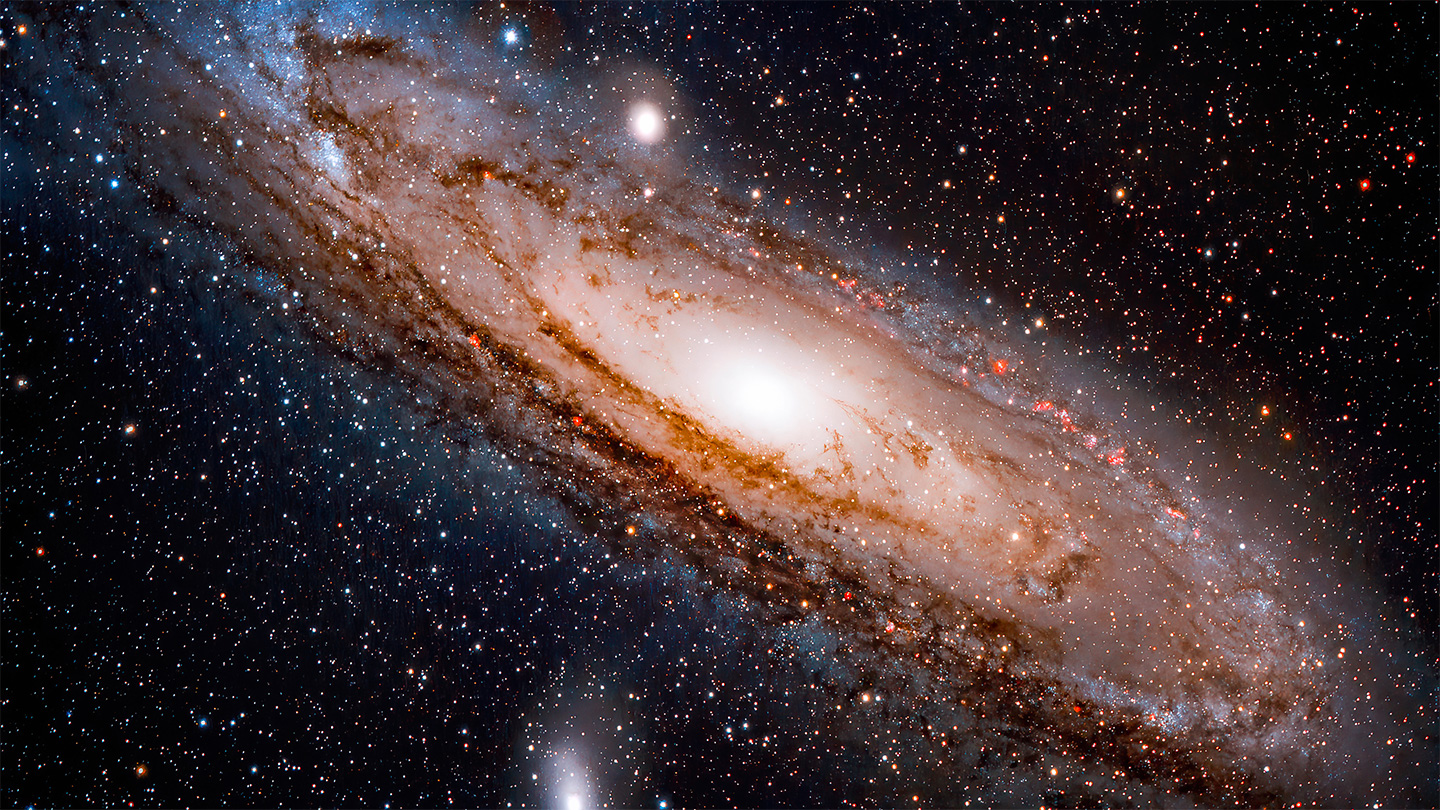The Dark Caustic Theory - A Test Against Observations In The Milky Way
According to this theory, the Milky Way is made up of sheets of cold, collisionless dark matter particles with angular momentum that flow in and out. At the locations of closest approach to the Galactic center, these flows form caustic rings (where the density of the flow is formally infinite). A roughly logarithmic halo is produced by the dark caustic theory, with large perturbations near the rings.
Author:Suleman ShahReviewer:Han JuJul 18, 202321.9K Shares498.2K Views

According to this theory, the Milky Way is made up of sheets of cold, collisionless dark matter particles with angular momentum that flow in and out. According to the dark caustic theory, at the locations of closest approach to the Galactic center, these flows form caustic rings (where the density of the flow is formally infinite). A roughly logarithmic halo is produced by the dark caustic theory, with large perturbations near the rings.
The Milky Way's rotation curve can be reasonably predicted using this theory. N-body simulations were used to investigate the effects of caustic rings on dwarf galaxy tidal disruption. Simulations of the Sagittarius dwarf galaxy's tidal disruption in a caustic ring halo potential, in particular, match observations of the trailing tidal tail as far as 90 kpc from the Galactic center, but not the leading tidal tail.
What Is The Caustic Ring Dark Matter Halo?
Pierre Sikivie has spent the last 20 years developing the caustic ring dark matter theory. Although Sikivie began with Fillmore & Goldreich (1984) and Bertschinger (1985) spherically symmetric self-similar models, it is important to note that the Sikivie model has evolved to include the physics of dark matter particles beyond a simple gravitational interaction. Dark matter flows spin with the stellar disk as a result of this physics.
The caustic ring model is compatible with a universe that expands with the Hubble flow and has power-law density fluctuations that produce individual galaxies' seeds. The velocity dispersion at any point in space is zero because dark matter starts out on these density fluctuations with temperature zero. Dark matter gains velocity as it falls into a galaxy, but because it only occupies three dimensions of the six-dimensional phase space (three spatial dimensions and three velocity dimensions), it collides with discrete flows that only occupy three dimensions of the six-dimensional phase space. The infalling flows, like the particles that make them up, fall in toward the galaxy center until they get as close as they can get, then fly out until all of the kinetic energy has been converted to gravitational potential energy, then turn around and fall back in.
What Are The Caustic Rings And Hierarchical Structure Formation?
Although the caustic ring model does not account for the effects of hierarchical merging, it is plausible in light of the Milky Way's merger history. Large galaxy mergers will destroy dark matter caustics in the same way that galaxy mergers disrupt star disks and other colliding particle structures.
Any dark matter that falls in after the collision will, however, remain intact on the three-dimensional (3D) sheets in six-dimensional (6D) phase space. The flow of dark matter in a caustic ring causes a local thickening in the phase space sheet and a velocity dispersion as a result of a merger. Minor mergers will cause the caustics to spread and become fuzzy, but as material from the cold flow fills in the caustic, the caustic will sharpen again after the merger event. Minor mergers, such as the one affecting the Sagittarius dwarf galaxy, which is currently being disrupted by the Milky Way's tidal forces, would have no effect on the caustics' structure.
Some of the effects of the Bose–Einstein condensate (BEC) model are still being incorporated into the caustic ring model. When the axion self-interactions are taken into account (the particles share angular momentum), the axions in this special degenerate condensed state create a vorticity that is more permanent than the original model.
Does A Caustic Ring Halo On The Nature Of Dark Matter Have Any Implications?
In the standard caustic ring halo, the density fluctuations that precede galaxies are spherical by design. If the dark matter is also not rotating, it falls in along radial orbits, and the inner caustic forms a cusp at the center of each galaxy, with a density that diverges. The caustics form tricusp rings in the plane perpendicular to the axis of rotation at the positions of the inner turnaround radii of the dark matter flows only when the dark matter has net rotation. In contrast to CDM simulations, where the angular momentum of the dark matter distribution in most simulated galaxies is small, this is a significant difference. To form the proposed caustic ring halos, a specific type of dark matter is required.
Although dark matter can pick up net rotation through hierarchical merging, the angular momentum of a galaxy as a whole is thought to be caused by a tidal torque from nearby protogalaxies early in its formation, before the galaxy has condensed out of the expansion of the universe. Because dark matter is usually modeled as a collection of collisionless particles, a tidal torque would be unexpected. Axions in a rethermalizing BEC, on the other hand, will respond to a tidal torque by entering the lowest energy state compatible with the acquired angular momentum. On the turnaround sphere, that state is one of rigid rotation.
Calculating The Caustic Ring Gravitational Field
Because the acceleration calculated in the caustic ring model is not the acceleration due to an excess of matter on a ring; rather, it is the acceleration due to one sheet of dark matter falling into the Milky Way, there is no way to add the caustic rings to a standard halo density model, such as a Navarro–Frenk–White (NFW) profile. To calculate the gravitational field for the entire halo, add all of the accelerations due to all of the 20 sheets of matter that have fallen in over the last Gyr. This final acceleration calculation takes into account all of the halo dark matter, including the ring caustics. The overall shape of the halo cannot be changed; it simply falls out of the sum of the integrals.
Comparison Of The Caustic Ring Halo With Other Halo Models
The following is a list of the halo potential models (NFW and logarithmic) that will be compared to the caustic ring model in this paper. In addition, for all models used in this paper, X, Y, and Z are Galactocentric Cartesian coordinates.
The acceleration of the caustic ring halo is compared to that of an NFW halo and a spherical log halo. As a function of distance from the Galactic center, the NFW and log halos accelerate. We show acceleration in the plane (z = 0) as a function of cylindrical radius ρ, and along the axis of symmetry (ρ=0) as a function of z for the caustic ring halo, which is not spherically symmetric but axially symmetric. The acceleration is moving toward the Galactic center in either case. The obvious feature is that there are large jumps in acceleration in the Galactic plane at the positions of the caustic rings.
Comparison Of The Caustic Ring Halo With The Milky Way Rotation Curve
Contributions from the dark matter halo, the baryon disk, and the stellar bulge all contribute to the Milky Way Galaxy's potential. In this paper, we model baryons in stars and gas in the Milky Way using analytical disk and bulge potentials.
The NFW halo, on the other hand, predicts a much higher mass for the inner Galaxy. The disk model curve and the NFW halo curve are almost level. This reveals a flaw in fitting the rotation curve data with a disk or halo model. The maximum disk hypothesis is supported by the choice of either a caustic ring halo or a log halo. This is the idea that the disk should contribute the most to the rotation curve of the inner Galaxy (50%–90% of total radial force), and it assumes that the disk's mass-to-light ratio is unaffected by the radius.
What Is The Sagittarius Dwarf Tidal Stream?
Tidal streams are clumps of stars that have been gravitationally stripped from dwarf galaxies and orbit much larger galaxies. Two streams or "tails" of stars form when a dwarf galaxy's tidal disruption occurs. The trailing tail moves behind the leading tail, which moves ahead of the orbit of the bound dwarf galaxy. The tidal stream in the Sagittarius (Sgr) dwarf galaxy is the Milky Way's largest and best-studied.
The Sgr stream has been used to constrain the shape of the dark matter halo by measuring the Milky Way potential. However, fitting Sgr tidal debris data to halo models has proven difficult. Spiral, prolate, and oblate ellipsoid models have all been proposed.
The Effect Of A Dark Matter Caustic Ring On A Satellite Passing Through It
To see if the high-density areas would have a strong effect on tidal disruption, we ran N-body simulations of dwarf galaxies represented by Plummer sphere models on orbits that pass close to caustic rings. We discovered that, despite a significant discontinuity in acceleration near a caustic, the gravitational field of the caustic ring has no qualitative impact on the simulation results. The shapes of the orbits and the resulting tidal tails in a caustic ring halo potential differ from those in a spherical log halo potential.
The formation of tidal tails is influenced by the caustic rings in a subtle way, but the differences aren't significant. The Monoceros Ring, a ring of stars about 20 kpc from the Galactic center, is thought to be linked to a dark matter caustic ring at 20 kpc, which is the subject of this section's research.
People Also Ask
What Is An Orbit Fitting?
An orbit (line through phase space) of a test particle through a particular external potential is specified by initial conditions for position and velocity. We generate orbits using the mkorbit and orbint tools from the NEMO Stellar Dynamics Toolbox.
What Does The Sagittarius Dwarf Tidal Stream Mean?
It consists of tidally stripped stars from the Sagittarius Dwarf Elliptical Galaxy, resulting from the process of merging with the Milky Way over a period of billions of years.
Is There Any Evidence For A Caustic Ring Dark Matter Halo?
Some observational evidence that caustic rings might exist in galaxies has been put forward by previous authors. This evidence includes the statistical distribution of bumps in the rotation curves of 32 galaxies and the distribution of bumps in the rotation curve of the Milky Way.
Conclusion
The caustic ring halo can reasonably match the known Galactic rotation curve, but an association between the positions of the caustic rings and oscillations in the observed rotation curve has not been confirmed or ruled out. The values discovered for the disk mass, scale length, and scale height are comparable to those discovered in other studies that fit Galaxy component models to observations.
Simulations of the Sagittarius dwarf galaxy in a caustic ring halo potential with disk and bulge parameters tuned to match the Galactic rotation curve match observations of trailing tidal tails as far as 90 kpc from the Galactic center. They are, like the NFW halo, unable to match the leading tidal tail. None of the caustic, NFW, or triaxial logarithmic halos can match the leading and trailing arms of the Sagittarius stream at the same time.
Jump to
What Is The Caustic Ring Dark Matter Halo?
What Are The Caustic Rings And Hierarchical Structure Formation?
Does A Caustic Ring Halo On The Nature Of Dark Matter Have Any Implications?
Calculating The Caustic Ring Gravitational Field
Comparison Of The Caustic Ring Halo With Other Halo Models
Comparison Of The Caustic Ring Halo With The Milky Way Rotation Curve
What Is The Sagittarius Dwarf Tidal Stream?
The Effect Of A Dark Matter Caustic Ring On A Satellite Passing Through It
People Also Ask
Conclusion

Suleman Shah
Author
Suleman Shah is a researcher and freelance writer. As a researcher, he has worked with MNS University of Agriculture, Multan (Pakistan) and Texas A & M University (USA). He regularly writes science articles and blogs for science news website immersse.com and open access publishers OA Publishing London and Scientific Times. He loves to keep himself updated on scientific developments and convert these developments into everyday language to update the readers about the developments in the scientific era. His primary research focus is Plant sciences, and he contributed to this field by publishing his research in scientific journals and presenting his work at many Conferences.
Shah graduated from the University of Agriculture Faisalabad (Pakistan) and started his professional carrier with Jaffer Agro Services and later with the Agriculture Department of the Government of Pakistan. His research interest compelled and attracted him to proceed with his carrier in Plant sciences research. So, he started his Ph.D. in Soil Science at MNS University of Agriculture Multan (Pakistan). Later, he started working as a visiting scholar with Texas A&M University (USA).
Shah’s experience with big Open Excess publishers like Springers, Frontiers, MDPI, etc., testified to his belief in Open Access as a barrier-removing mechanism between researchers and the readers of their research. Shah believes that Open Access is revolutionizing the publication process and benefitting research in all fields.

Han Ju
Reviewer
Hello! I'm Han Ju, the heart behind World Wide Journals. My life is a unique tapestry woven from the threads of news, spirituality, and science, enriched by melodies from my guitar. Raised amidst tales of the ancient and the arcane, I developed a keen eye for the stories that truly matter. Through my work, I seek to bridge the seen with the unseen, marrying the rigor of science with the depth of spirituality.
Each article at World Wide Journals is a piece of this ongoing quest, blending analysis with personal reflection. Whether exploring quantum frontiers or strumming chords under the stars, my aim is to inspire and provoke thought, inviting you into a world where every discovery is a note in the grand symphony of existence.
Welcome aboard this journey of insight and exploration, where curiosity leads and music guides.
Latest Articles
Popular Articles


